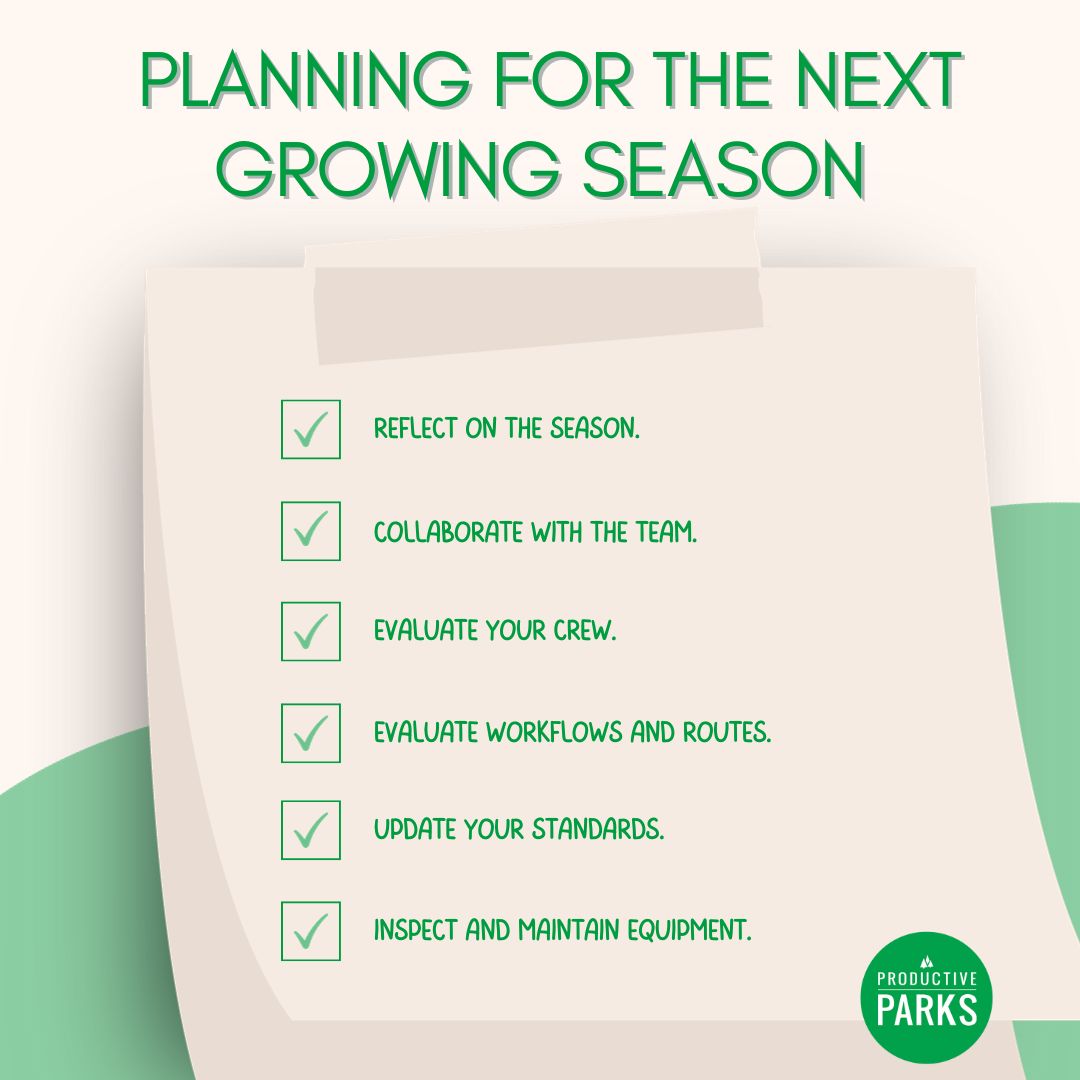
You’ve just about made it through another busy growing season. Chances are you had some smooth patches and some challenges along the way.
As things start slowing down for the season, now is an excellent time to prepare for next year.
Sure, you may not even want to think about next year right now. But starting to plan can make next year go so much smoother.
In this article, we’ll review some things you and your team can do to evaluate this past growing season and plan your maintenance for next year.

Reflect on the Season
Grab a cup of coffee and a notepad--or your laptop--and take notes about this past growing season. Jot down whatever comes to mind without worrying about organizing anything just yet.
Consider questions like:
- What were some things my team did well this season?
- What challenges did we face?
- What were the inefficiencies?
- Which staff showed the best leadership and teamwork?
- What parks or assets required the most attention?
- What were some issues we encountered we didn’t anticipate?
- Where did we go over budget? Underbudget?
- How can we be more efficient next year?
Next, put away those notes for a few days. When you return to them, list some main points you want to discuss with other managers.
Encourage others on your team to do the same.
Collaborate with the Team
Once everyone had time to reflect on how things went this season, schedule time to discuss everything.
Hear everyone’s point of view about how the season went. Make a list of positive highlights and the challenges each person in the meeting encountered.
Use this meeting as a starting point for future discussions on how to plan next year’s maintenance.
Evaluate Your Crew
Complete a performance evaluation for each employee. Ideally, the process will be standardized and based on tangible benchmarks.
Make any feedback clear, specific, and fair. Clarify any standards expected for the position. Provide concrete steps to pave the way for improvement.
Also, allow the employee to give feedback. Their insights can give you great ideas about what’s going well and what needs work.
Offer different options for feedback sessions. Some employees may be uncomfortable or less honest in a face-to-face setting. For example, give opportunities for written suggestions, an anonymous online survey, or a “town hall” meeting with other maintenance staff.
Acknowledge their good work and make them feel valued--this will make them more likely to return next year if the opportunity exists.
Evaluate your Workflow and Routes
Examine work routines for efficiency. Are there any tweaks to save time, fuel, and labor hours? Maybe some standard operation procedures aren’t as clear or well-defined. Examine routes for more efficient traveling. Evaluate your routine tasks to ensure you do them enough without overdoing them.
Other aspects of your workflow to evaluate include:
- Mowing routes
- Garbage Collection/Litter Removal Procedures
- Routine Maintenance Schedules
- Inspection Assignments
- Preventative Maintenace Procedures
- Opening/Closing Duties
- Work Order Process
- Standard Operating Procedures
Update Your Standards
Hopefully, you’ve had a method to collect data on labor hours, asset loads, etc. With all that data in place, look at all your standard time for the routine tasks your team completes.
Standard time is the average time a qualified worker completes a task under normal conditions and at a normal pace.
Are there any standards that need to be revised? Maybe a park was renovated recently, and mowing takes longer to navigate. Or additional equipment in the fitness area takes longer to clean and inspect.
If you use more traditional methods to collect data, it may be time to review all the work reports and time sheets to get the needed numbers.
If you used computerized maintenance management software (CMMS) this season, gathering and analyzing the data will be a relatively simple and quick process. CMMS software is designed to create quick reports based on the data entered throughout the season.
Inspect and Maintain Equipment
Finally, ensure your equipment is ready to come roaring out of storage at the beginning of the next growing season. Schedule inspections and maintenance tasks to ensure safe winter storage and easy startup in the spring.
Keep records of the completed work so everything is clear come spring.
The Takeaway
You can do a lot now to prepare your maintenance team for next year. It’s a great idea to evaluate your season, processes, employees, and workflow while it is still fresh in your mind. Get input from different sources and be open to discussions where other options get explored.
If you don’t have the records or data you need to help with decision-making, it may be time to consider using maintenance management software before the next growing season. This software may make things much easier for you and your team this time next year.
